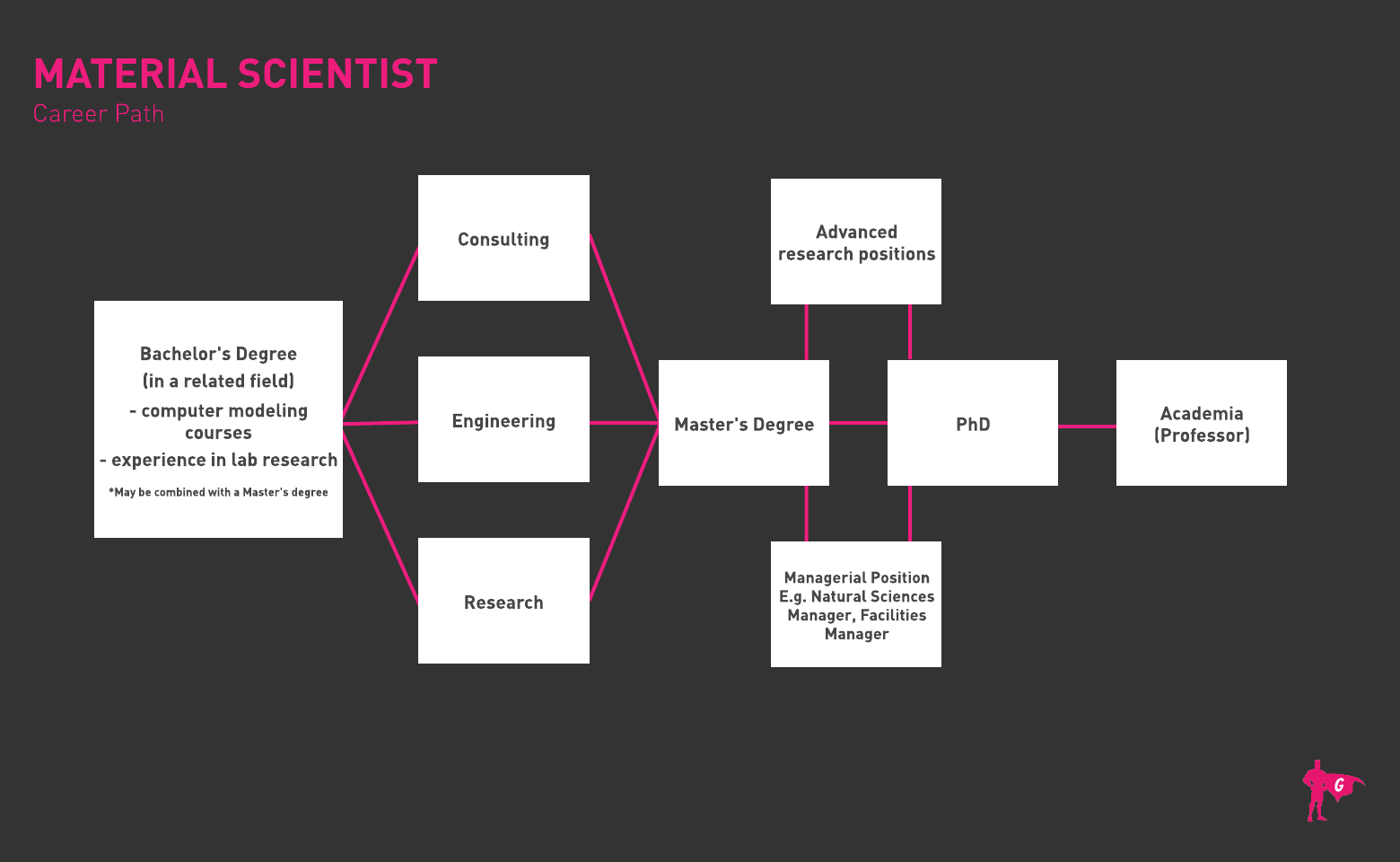Spotlights
Tiêu đề tương tự
- Polymer Materials Consultant
- Research and Development Scientist (R and D Scientist)
- Nhà khoa học nghiên cứu
- Glass Scientist
- Ceramic Scientist
- Metallurgical Scientist
- Polymer Scientist
- Composites Engineer
- Biomaterials Scientist
- Nanomaterials Scientist
Mô tả công việc
Materials scientists study the structures and chemical properties of natural or synthetic materials (e.g. metals, rubber, ceramics, glass, etc.) in order to determine the quality of manufactured products, improve products and develop new products. These tasks may involve strengthening or combining materials to improve their efficacy.
Các khía cạnh bổ ích của sự nghiệp
- Satisfaction from being involved in a project from its conception to the final outcome
- Working with, and learning from, other professionals from a variety of fields (e.g. engineers and processing specialists)
- Intellectual stimulation
Muỗng bên trong
Trách nhiệm công việc
Nghiên cứu
- Basic research: plan and execute research on the structures, composition and properties of materials (e.g. metals, ceramics, alloys, lubricants and polymers)
- Applied research: use information obtained from basic research to develop new products or improve existing ones
- Record detailed notes throughout the research process
Experiment
- Use computer modeling to study the response of various materials to applied forces or other treatments
- Conduct tests on materials to ensure they meet safety and quality standards
- Determine the efficacy of combined materials or newly developed materials when used in products and applications
Report
- Prepare technical and detailed reports that indicate methods and findings, to be used by other scientists, sponsors, and/or customers
- May also have to verbally/visually present findings to other scientists
Kỹ năng cần thiết
Kỹ năng mềm
- Tư duy phản biện
- Suy luận suy diễn
- Giao tiếp bằng văn bản và bằng miệng
- Organization/Time-management
Kỹ năng cứng
- Vật lý học
- Hóa học
- Engineering and Technology
- Toán học
Kỹ năng kỹ thuật
- Computer modeling software
- Analytical/Scientific software (e.g. SPSS)
- Spreadsheet software (e.g. Excel)
Các loại tổ chức khác nhau
- Industrial manufacturing company
- Chính phủ
- Academia (Universities/Colleges)
- Research and development for companies engaged with the physical, engineering, and life sciences
Kỳ vọng và hy sinh
Dedicating a lot of time to studying and training
Xu hướng hiện tại
- 3D printing with more than plastic (e.g. glass, ceramic)
- New materials for consumer electronics (e.g. constructing smartphones with ceramics and glass)
Giáo dục và đào tạo cần thiết
Yêu cầu cơ bản
- Bachelor’s Degree in a related field (e.g. Chemistry, Materials Science, Materials Engineering) for entry-level jobs.
- Requisite courses for attaining skills in computer modeling, which is heavily relied upon in research and development programs. Also courses in organic, inorganic, and physical chemistry, along with plenty of math, physics, biological sciences, computer science, and labs.
- O*Net reports that 38% of Material Scientists have a bachelor’s, 24% a master’s, and 24% a PhD
- College programs should ideally be accredited by the American Chemical Society
- Many employers will provide new employees with on-the-job training specific to their function within the organization
- Lab work is often done via internships, cooperative programs, or work-study experiences
Tips
- Some fast-tracked programs offer a combined bachelor’s/master’s in Chemistry, and accelerated 4+1 BS/Master’s dual degree programs.
- Some Chemistry programs offer a specialization in Materials Science
Thăng tiến nghề nghiệp
- Master’s Degree or PhD in a related field for research positions
- Graduate courses may include subfield topics like medicinal chemistry
- Additional certifications include:
- Society of Tribologists and Lubrication Engineers - Certified Lubrication Specialist
- The Association for Materials Protection and Performance - Corrosion Specialist and Protective Coatings Specialist
- World Safety Organization - WSO Certified Hazardous Materials Supervisor
Những việc cần làm trong thời gian học trung học/ đại học
- In high school, load up on advanced classes in chemistry, math, and computer science to prepare for college
- In college, gain experience in lab research through internships, fellowships, or work-study programs
- Map out your career goals to determine if you’ll want or need a graduate degree
- Decide if you want to do an accelerated dual degree bachelor’s/master’s
- Determine which learning method works better for you — in-person, online, or hybrid. Some students may opt to do their undergrad degree in person and their master’s online
- Work with your academic advisors on appropriate electives to bolster your major
- Figure out what you want to specialize in, such as ceramics, glasses, metals, nanomaterials, polymers, and semiconductors
- Join professional organizations such as the American Chemical Society to network, stay engaged, and discover opportunities
- Keep up with industry trends by reading the Journal of Materials Science, Materials Today, and other relevant publications
Lộ trình điển hình

Làm thế nào để có được công việc đầu tiên của bạn
- College summer/semester internships allow for networking within a company: Build connections during these internships to gain references and potentially roll into a full-time position after graduation
- Networking is also facilitated through college/university activities and events. Work with your school’s career center to find jobs, polish your resume, and practice interviewing.
- LinkedIn: Các nhà tuyển dụng tiềm năng xem hồ sơ của bạn, vì vậy hãy đảm bảo rằng nó được cập nhật và phản ánh hiệu quả các kỹ năng và thành tích của bạn. Hãy chắc chắn rằng bạn kiểm tra tin nhắn của bạn thường xuyên quá.
- Online applications- typically through job search engines, e.g. Monster (type up your info, attach a PDF of your resumé, and send it off)
- Old-school method: get in your car, and drive up to the office with a copy of your resumé. Keep appearing at the office if that is what it takes. This is also the best way to see the work environment and what you’ll be doing, to determine if you really want to work at that location
- Consider where Materials Scientists are employed! 25% of workers are employed in R&D, 15% in chemical manufacturing, 14% in company management, 10% in computer/electronic product manufacturing, and 7% in architectural, engineering, or related services
- Move to where the jobs are! The Bureau of Labor Statistics notes that the highest concentration of jobs for Materials Scientists are in Delaware, New Hampshire, Washington, Maryland, and Iowa. The states with the highest employment levels are New York, California, Illinois, Pennsylvania, and Washington
- BLS also notes that Materials Scientists will be increasingly needed to help in the energy and transportation sectors, and in the electronics industries
- Review Materials Scientist resume templates for ideas
- Đảm bảo sơ yếu lý lịch của bạn có tác động, hấp dẫn, không có lỗi và chứa nhiều số liệu thống kê và chi tiết
- Look for opportunities on Indeed, Glassdoor, and other job portals. Advertise your availability on LinkedIn, too
- Hỏi trước các tài liệu tham khảo tiềm năng trước khi cung cấp thông tin liên hệ của họ
- Review Materials Scientist common interview questions like “How do you determine the best combination of materials for a particular project?” Think about how you’d answer the tough questions!
- Practice mock interviews so you can present yourself as well-prepared and confident
- Go over the applicable terminology for materials science
Những gì nó thực sự cần để làm cho nó và thành công
- Being detail-oriented
- Khả năng làm việc độc lập
- High degree of mental focus
- Natural aptitude in science and statistics
Tài nguyên được đề xuất
Trang web
- The Materials Research Society
- The Materials Information Society
- Materials Today
- Hiệp hội vì sự tiến bộ của khoa học Hoa Kỳ
- Hiệp hội Hóa học Hoa Kỳ
- American Chemical Society Committee on Professional Training
- American Chemical Society Green Chemistry Institute
- American Chemistry Council
- Viện Kỹ sư Hóa học Hoa Kỳ
- American Physical Society
- American Vacuum Society
- ASM International
- IEEE
- Journal of Materials Science
- Materials Research Society
- Materials Today
- National Resource Center for Materials Technology Education
- Materials Witness
- Watch a Materials Scientist in action
Sách vở
- Mechanics of Materials, by Russell Hibbeler
- Concepts of Materials Science, by Adrian P. Sutton
- Materials Selection in Mechanical Design, by Michael F. Ashby
Kế hoạch B
Apart from research, professionals trained in materials science may work in materials/chemical engineering or education
Nguồn cấp tin tức

Việc làm nổi bật

Các khóa học và công cụ trực tuyến







